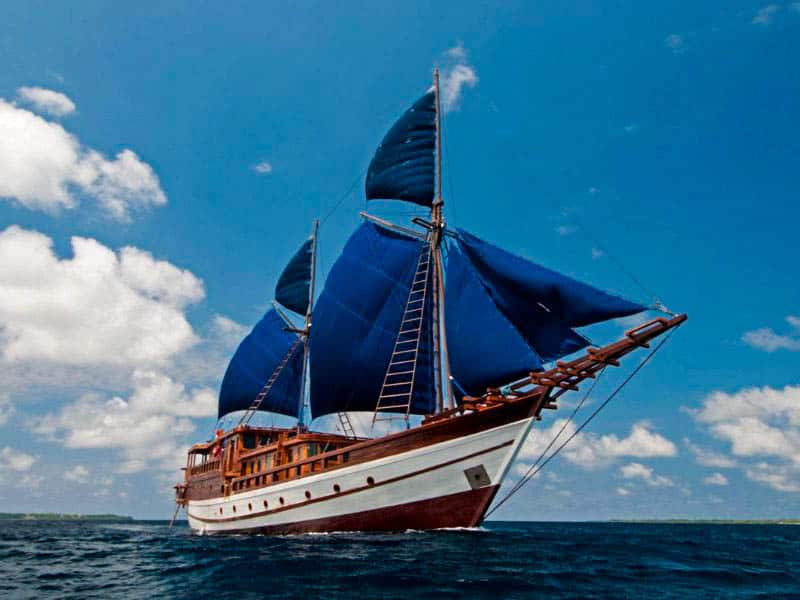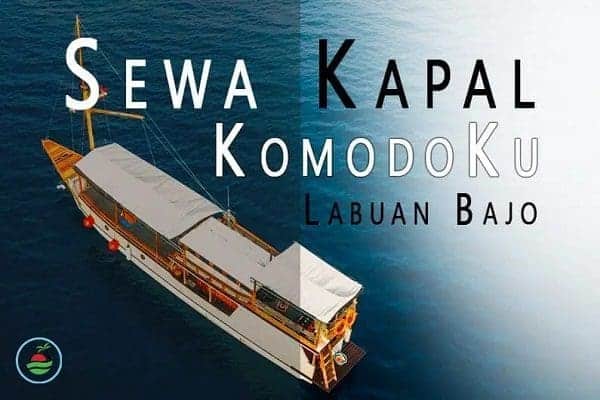The Origin of the Pinisi Ship – A pinisi ship is a ship equipped with sails, masts and ropes. This large ship is undoubtedly popular in Indonesia. The Pinisi ship comes from Sulawesi Island.
Even though it is popular, many Indonesian people do not know the background to the creation of this ship. So, if you are curious about the origin of the Pinisi ship, read this article to the end, okay?
The Origin of the Pinisi Ship
The pinisi ship comes from the Bugis tribe in South Sulawesi. The Bugis tribe who live in Bulukumba Regency, South Sulawesi, are famous for their expertise in navigating the seas of the archipelago and the world.
Although many people believe that ships using the pinisi system have existed since the 14th century, no evidence has been found to support this claim.
On the other hand, research found that Prince Sawerigading's ship, namely the Welenrengnge ship, was used to sail to various places, but was not the pinisi type.
According to local tradition, King Tallo named the ship pinisi, which is a combination of two words, picuru, which means "good example", and binisi, which refers to a species of small, agile fish.
However, there are also those who believe that the name of the ship comes from the Bugis language, specifically panisi which means insert.
The Pinisi ship was discovered at the end of the nineteenth century, according to some historical accounts. Meanwhile, a craftsman from the villages of Ara and Lemo-Lemo in South Sulawesi created the first native Sulawesi pinisi in 1906.
This ship uses a pinisi sail system, with seven or eight sails on two masts standing at the front and rear. Even so, this pinisi screen method is not completely new. However, this system was modeled after the European Schooner-ketch Sailing system.
Only a few people realize that pinisi ships are made in a very unique way. So, pinisi ships are made through a simple ritual, namely cutting the keel.
The keel is the most basic component of a ship. This ritual requires preparing various kinds of food, including sweet snacks and white roosters. So how do you understand the origins of the Pinisi ship?
See also:
Facts and Myths about the Pinisi Ship that are Often Misunderstood
Who doesn't know the Pinisi Ship? This famous sailing ship from Bulukumba is recognized for its ability to navigate the ferocious oceans.
Even more extraordinary, in 2017, UNESCO named the Pinisi shipbuilding as a Masterpiece of Human Oral and Intangible Heritage in 2017.
However, even though it is brilliant, misunderstandings regarding the origin of the Pinisi ship still exist in cultural memory. What's that? Check out the full review below:
1. The Pinisi ship cost billions of Rupiah
The price of a Pinisi boat is determined by the size and model the customer prefers. The price range starts from 3 billion rupiah to tens of billions.
2. The Pinisi ship was only founded in the 20th century, not hundreds of years ago
There are at least three myths surrounding the origin of the Pinisi ship. First, the story of Sawerigading who claimed to have used the Pinisi ship to sail from Luwuk to Mainland China to find a mate. This story is said to be documented in the Epic of La Galigo.

However, various studies show that all the above assumptions are not true. According to Leibner's research presented at the 2016 Symposium, the ship in the La Galigo document was named waka, padewakang, or wakka Welenrengnge.
In fact, not a single word Pinisi appears in La Galigo's sureq, and the mainland China referred to is Ale Cina, an area on the southern coast of Sulawesi which is not actually China.
The second narrative is about the ancient sailor Bontobahari who successfully sailed to Venice, Italy. The city then inspired them to name their ship Pinisi.
In fact, the Pinisi ship was never recorded in the records and archives of the Dutch East India Company before the Colonial Government, and no Sulawesi ship ever stopped at Harbor Venice, Italy.
The third narrative is about I Manyingarang Dg Makkelo, a Tallo king who named his ship "Pinisi" in the 17th century.
The word "Pinisi" first appeared and gained popularity at the turn of the 20th century. Since then, there have been other attempts to explain the origin of the word "pinisi" (Leibner, 2016).
3. The word Pinisi refers to a type of sail, not a ship
Pinisi is the name of a type of sail, not a ship as many people think. It is a type of sail which in maritime vocabulary is known as "Schooner Ketch" or "Schooner" and is translated as schooner in Indonesian.
"Palari" type ships that have two masts and two rudders are the name for ships that most often use "Pinisi" type sails.
Another form of ship is the "Lambo" which is a modern variant of the Palari ship with a motor or diesel engine, especially in post-1975 ship production. There is no clear record of when this type of schooner was renamed the Pinisi ship.
However, in Bugis vocabulary, the expressions panisi (meaning "insert") or mappanisi (meaning "insert") refer to the process of caulking wood for shipbuilding (lopi). The word panisi was then changed to pinisi. The origin of the Pinisi ship is quite interesting, isn't it, Travela?
4. Pinisi do not originate from Bulukumba
The Pinisi sailing ship is a traditional ship which is thought to have originated from Bulukumba, more specifically Tanah Beru, Bonto Bahari District.
Even when we type pinisi in KBBI, the explanation is almost the same, namely describing the Pinisi ship as a typical ship from Sulawesi. That's right, if you ask where the Pinisi sailing ship is located, the answer is currently centered in the Ara area, Lemo-Lemo, and Tanah Beru in Bulukumba.
In fact, sailors from this area have long been known as skilled shipbuilders (Panrita Lopi), as documented a century ago in the newspaper Bataviaasch Nieuwsblad in 1939.
The Pinisi sail (Schooner Ketch) comes from Europe, where Bugis-Makassar sailors, especially the Bulukumba tribe, adopted it. What's different is the way the screen rolls.
The European schooner's sails were rolled upwards, while the Pinisi sails were rolled lengthwise towards the front. How do you understand the origins of the Pinisi ship?
5. Internationally Recognized Pinisi Shipbuilding Traditions and Systems
Professional Pinisi shipbuilders (Panrita Lopi) have a broad understanding of sailing and shipping. Their shipbuilding expertise and reputation have received international recognition.
The Bontobahari ship industry is distinguished by its complex and consistent shipbuilding system, especially ship hulls (Fitria, 2021).
Interestingly, they can combine the latest maritime knowledge with a touch of local wisdom (local genius) in the shipbuilding process.
A Panritta Lopi (ship builder) must carry out at least five traditional rituals, namely:
- Appasili Ceremony (Tolak Bala) Barazanji Reading
- Ammosi Ceremony (Giving the navel)
- Anyorong Lopi Ceremony (Takeoff stage on the high seas)
- Keel Cutting Ceremony (Annakbang kalabiseang)
- Lunar Connection Ceremony (Annatta)
In addition to local craftsmanship, Panritta used oral traditions to create the ship's structure.
Antonia Soriente (2019) explains that oral traditions play an important role in the Pinisi shipbuilding process. This tradition can be adapted into a shipbuilding plan in someone's memory.
Interestingly, this skill has been passed down from generation to generation. Therefore, Panritta Lopi is not a suitable position for everyone. The origins of the Pinisi ship are indeed interesting to study.
Come on, read other interesting information:
- JK's suggestion regarding Komodo tickets: Lower it to IDR 1 million
- Pocong Village, is the place as scary as its name?
- South Sulawesi Healing Place | 14 Popular Makassar Destinations
6. The historic voyage of the Pinisi Ship to the American Continent
Phinisi Nusantara is a Pinisi sailing ship that received international recognition at the Vancouver Expo 86.
According to the Lipi Oceanography page, initially there were many cynical responses from various parties. Even the national media described the Phinisi Nusantara ship cruise as a coffin shipping project.
But in the end, the Phinisi Nusantara ship realized the plan beautifully, dispelling all previous doubts. Admiral Sudomo began an expedition across the Pacific Ocean on July 9, 1986, from the port of Muara Baru in Jakarta.
The ship was then captained by Captain Gita Ardjakusuma, a former TNI-AL officer. This expedition took 69 days from Jakarta to Vancouver (Canada) via Honolulu (Hawaii), covering a distance of approximately 11.000 miles.
That's the information about the origin of the Pinisi ship, its history and facts, hopefully it's useful!



